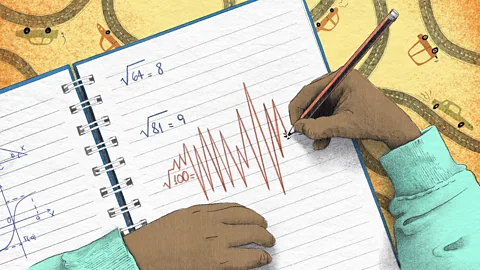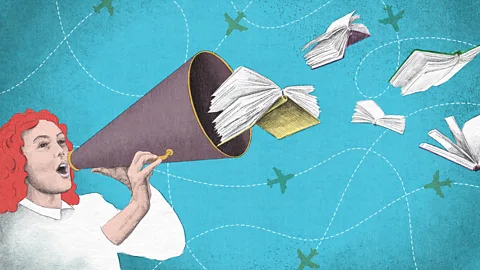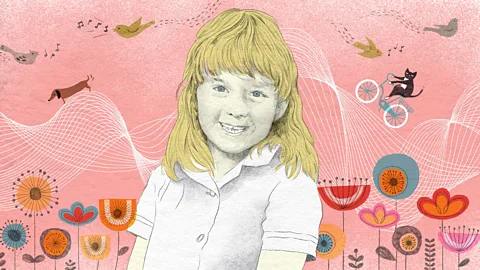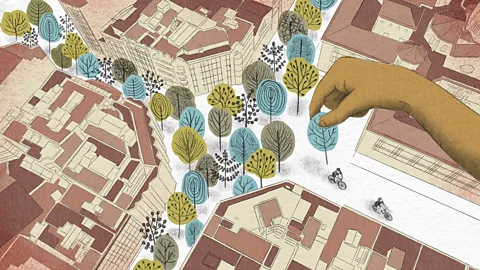How traffic noise hurts children's brains
 Emmanuel Lafont/BBC
Emmanuel Lafont/BBCAs awareness grows of the toll noise has on children's health and learning, some cities show the way to quieter roads and classrooms.
In a New York classroom, noise levels were so high that the teacher had to scream to be heard. The classroom was located near a subway train on raised tracks which passed by Public School 98 in Manhattan about 15 times a day, causing constant interruptions in the learning process.
For many years, people had complained about the noise levels at Public School 98, and in 1975, Arline Bronzaft, associate professor of psychology at Herbert H. Lehman College of the City University of New York, published a study examining the impact of noise on children's reading ability. She found that students who sat on the noisy side of the school building adjacent to the tracks performed poorly on reading tests compared to those on the quiet side of the building. The average reading scores of the classes on the noisy side lagged three to four months behind those of students on the quieter side.
As a result of Bronzaft's findings, the Transit Authority installed rubber pads on the tracks to reduce noise, and the Board of Education equipped classrooms with sound-absorbing materials to create a better learning environment.
 Emmanuel Lafont/BBC
Emmanuel Lafont/BBCNoise pollution is a growing global problem. As populations increase, so do the noise levels that form the urban soundscape. The UN has warned that urban noise pollution is becoming a "global public health menace", which already leads to 12,000 premature deaths each year in the European Union, and affects an estimated 100 million Americans.
Environmental noise, particularly road traffic noise but also aircraft noise, is among the most damaging environmental factors to health, after air pollution. Such noise has been found to increase chronic stress and cause disturbed sleep and higher blood pressure. Noise and noise annoyance have been associated with mental health issues such as depression and anxiety, and noise exposure has also been associated with a greater diabetes risk. Loud noise from sources such as music through headphones, motorcycles and even leafblowers, can over time lead to hearing loss and tinnitus.
Defined as unwanted or disturbing sounds, noise pollution from increasing traffic and crowded schools, can also have a detrimental impact on babies' and children's health and development. This is particularly true for children from low socio-economic backgrounds, who are exposed to higher levels of environmental noise.
From Buenos Aires to Barcelona, cities have started introducing measures to tackle noise pollution, protect children's health, and prioritise pedestrians by improving inner city green spaces, reducing speed limits and introducing sound meters.
Deafening roads
In the US and European Union, road, rail and aircraft traffic are the dominant sources of noise pollution.
A 2022 study found that road traffic noise experienced by primary school children in Barcelona, Spain, slowed down their working memory and attention span, which is considered essential for many aspects of learning including problem-solving, reasoning, mathematics, and language comprehension.
 Emmanuel Lafont/BBC
Emmanuel Lafont/BBCThe study tested 2,700 children aged between seven and 10 years in 38 schools in Barcelona, Spain, four times a year. The researchers measured the external noise, at specific points within each classroom, repeating the process six months later to determine the average baseline level of noise pollution. Over the course of a year, the team performed online cognitive tests to evaluate the children's short-term memory and attentiveness every three months.
The Barcelona study, which built on previous research, found that noise levels generated by road, air and rail traffic can have a negative impact on children's cognitive function during the crucial stages of brain development. Unwanted noise in the classroom can cause a child to experience several possible negative responses, such as learned helplessness – low motivation to learn due to the lack of control in their environment – and impaired attention, the study found.
How loud is too loud?
• The World Health Organization recommends noise levels do not exceed 35 decibels in classrooms.
• In primary schools, average noise levels are 44 decibels when pupils are silent, 56 decibels when pupils are engaged in quiet activities, 65 decibels for individual work, such as working at tables where some talking is allowed, and 70-77 decibels for group work.
• Noise-induced hearing loss occurs after prolonged exposure to high levels of noise, exceeding 85 decibels.
The Barcelona study was the first to investigate the impact of exposure to noise fluctuation. The researchers found that sudden fluctuations of noise, from traffic outside the classroom, such as car honks or engine revving, were more likely to distract children, and cause them to miss important information, even at a lower than average noise level.
Maria Foraster, lead author of the study, researcher in epidemiology and an expert on noise and health, says the researchers decided to focus on noise fluctuations as there are no international guidelines in place that measure this.
The World Health Organization recommends less than 35 decibels of noise in classrooms to ensure good teaching and learning conditions. Over half of Barcelona's population is exposed to noise levels over 65 decibels between 8am and 10pm.
"The guidelines don't [mention] fluctuations and peaks. Every time there is a noise peak, it is a distraction which can affect children's attention [span] and working memory," says Foraster.
Another study by Foraster found that excessive exposure to environmental noise could interfere with the functional maturation of children's auditory brain, which processes auditory information.
 Emmanuel Lafont/BBC
Emmanuel Lafont/BBCA 2019 study from Birkbeck University in London, which analysed the impact of noise in classrooms, found that children between 5-11 years of age are especially vulnerable to noise if they have lower selective attention – meaning, the ability to maintain focus and block out unwanted distraction – and inhibitory control, which is the ability to control urges and think before reacting.
"If a child has poor working memory and if their selective attention or their inhibitory control is not great, then they are going to be much more distracted by the noise around them," says Natasha Kirkham, co-author of the study and a professor in developmental psychology at Birkbeck University in London.
"When there is a lot of noise around children in primary and secondary school, we know they do worse [academically]," she says.
Noise pollution is often worse in poorer areas. A 2023 study found that children attending schools in Texas with the highest exposure to road noise were significantly more likely to be black, Hispanic and eligible for free or reduced lunches.
Exposure to noise together with other factors that come from attending "a lower-resourced school in a lower-resourced area, can have a real knock-on effect to learning," says Kirkham.
"If you constantly feel aroused by sound, this could increase the cortisol response related to stress, and over time can have detrimental effects on physical and emotional health from childhood into adulthood," says Iroise Dumontheill, professor of cognitive neuroscience at Birkbeck University in London.
Continuous exposure to noise in the long term can interfere with the central nervous system and brain, increasing the likelihood of developing heart disease, stroke, dementia, and cognitive decline.
"So, potentially, noise exposure in childhood could affect the memory systems and mental health in adulthood," says Dumontheill.
Car-free zones
The best way to protect children from excessive noise is by reducing traffic around schools, says Foraster. Better urban design, such as separating schools from busy roads and adding parks and green spaces around school areas could also improve the learning environment for children, she says.
 Emmanuel Lafont/BBC
Emmanuel Lafont/BBCBarcelona is trying to do this by placing schools into so-called "superilles", or "superblocks", which are small neighbourhoods closed to through traffic and packed with green spaces where people can exercise or get together.
First introduced in 1993, this urban design concept aims to reduce air and noise pollution, by prioritising cyclists and pedestrians over cars and playgrounds and trees over parking spots. (Read more about Barcelona's car-free smart city experiment.)
The superblocks have been shown to reduce noise and air pollution in residential neighbourhoods in Barcelona. The creation of the San Antoni superblock has lowered average daytime noise levels by 3.5 decibels, a 5.2% reduction, according to data gathered over one year by sensors and sonometers and compiled in a 2021 report. It has also helped reduce air pollution.
"Superblocks definitely help reduce air pollution and exposure to noise," says Foraster. "They help reduce overall traffic by making the use of cars less attractive and promoting a more walkable city."
Barcelona plans to create 503 superblocks by 2030 as part of its urban mobility plan, which aims to convert one in three streets into traffic-calmed green spaces, and ensure that 80% of all journeys in the city avoid cars and happen on foot, by public transport or by bike. Cities around the world are following Barcelona's example by implementing superblocks, including Buenos Aires, Vienna, Los Angeles and Bogota.
Quieter schools and neighbourhoods could potentially have another benefit: happier children. Kirkham points out that noise not only affects how children learn – it may also affect how they feel.
A home-schooling study carried out by Kirkham during the Covid-19 pandemic, found that adolescents from noisier homes, who spent time in noisier classrooms, generally found noise more annoying. "It’s not just that noise is distracting, there is an emotional component. Children get irritated," she says.
--
If you liked this story, sign up for The Essential List newsletter – a handpicked selection of features, videos and can't-miss news, delivered to your inbox twice a week.
